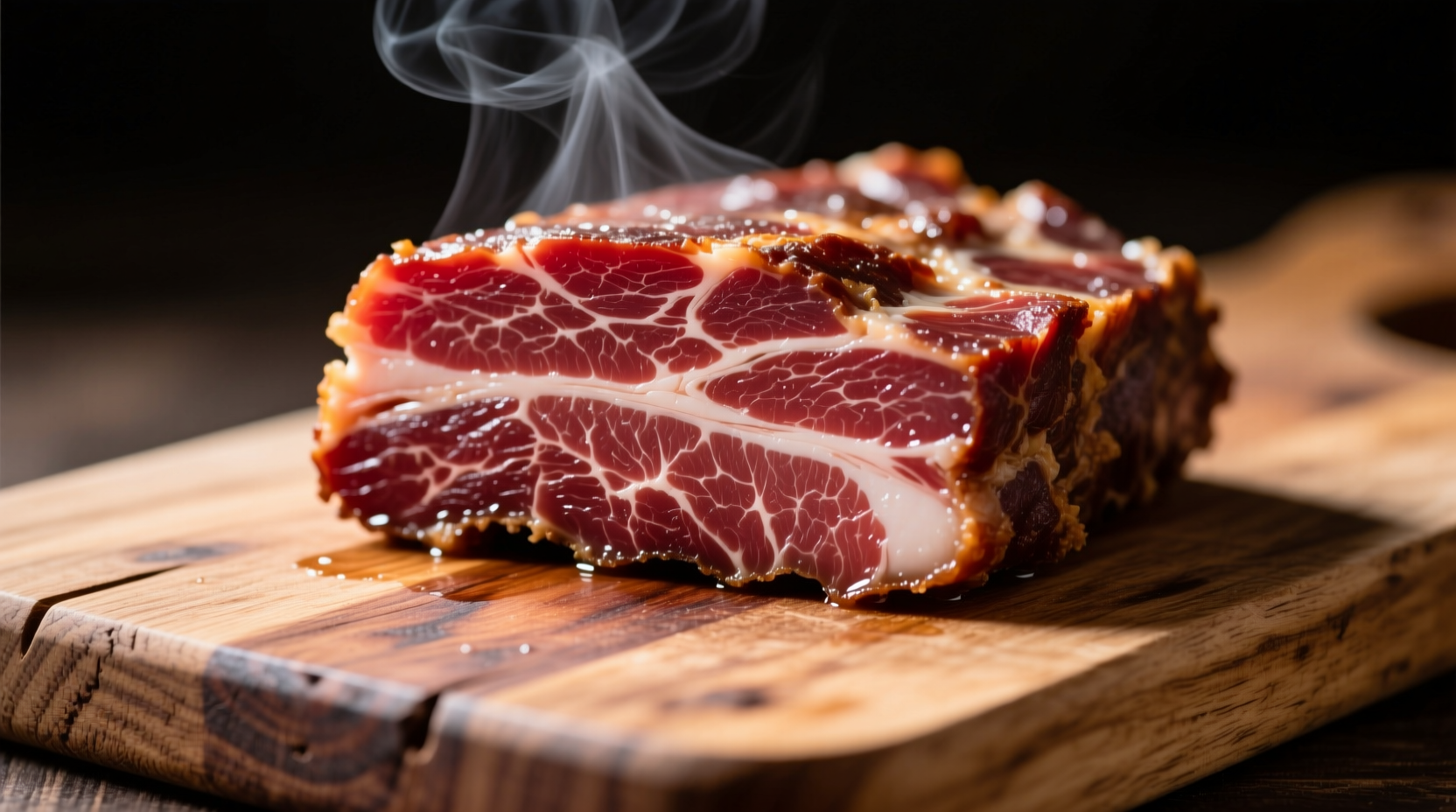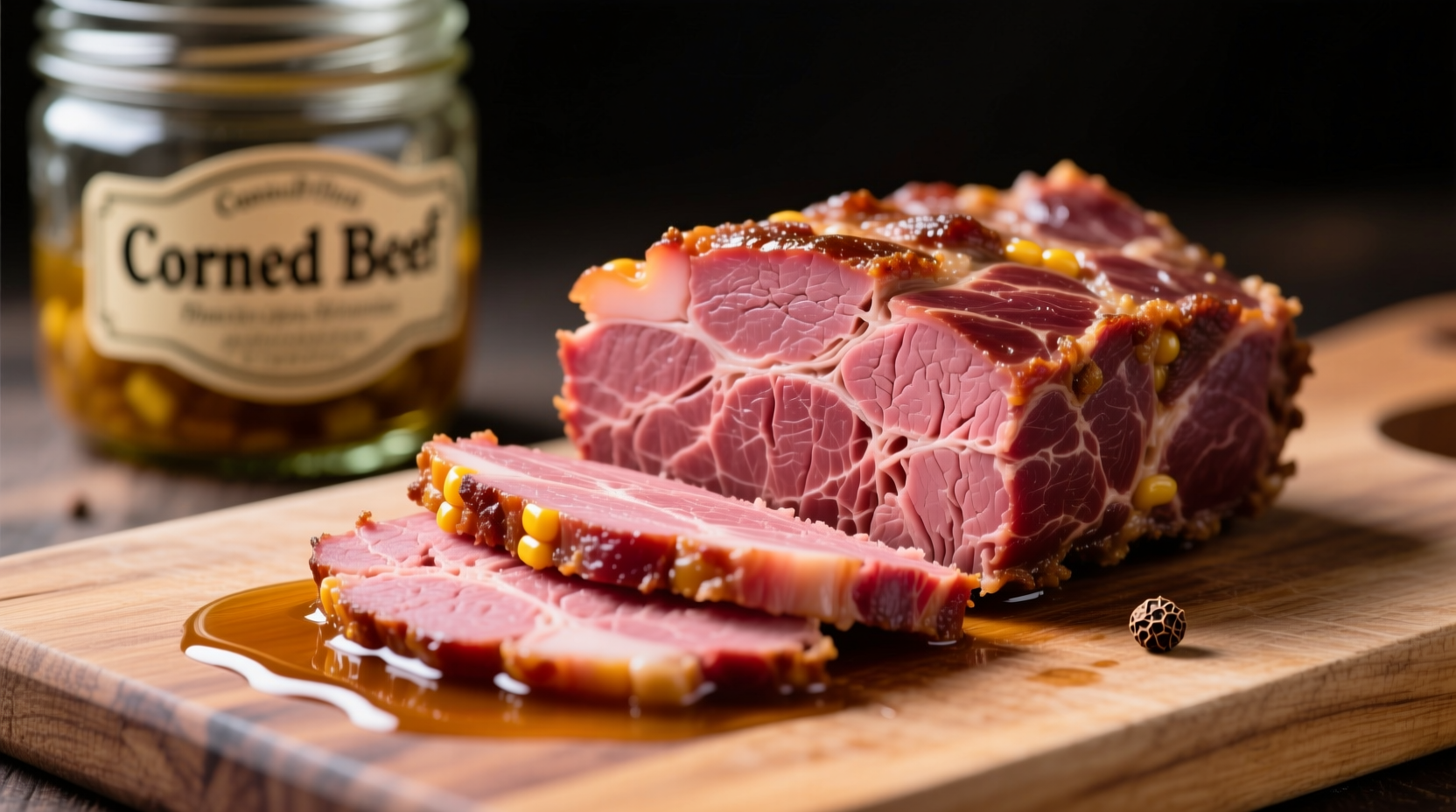If you've ever wondered what corned beef tastes like before trying it, you're not alone. This traditional cured meat has a unique flavor profile that sets it apart from regular beef. Understanding its distinctive taste helps you appreciate why it's featured in classic dishes from Reubens to traditional Irish dinners.
What Exactly Is Corned Beef?
Corned beef isn't a specific cut of meat but rather a preparation method. The term "corned" refers to the large "kernels" or grains of salt historically used in the curing process. According to the USDA Food Safety and Inspection Service, corned beef is beef brisket that's been cured in a seasoned brine solution for several days.
This curing process fundamentally transforms the meat's flavor, texture, and preservation qualities. Unlike fresh beef, corned beef develops a characteristic pink color throughout (thanks to sodium nitrite in the cure) and a texture that becomes remarkably tender when cooked properly.
| Flavor Component | Intensity Level | Contribution to Overall Taste |
|---|---|---|
| Saltiness | High | Primary flavor note from curing process |
| Umami | High | Natural meatiness enhanced by curing |
| Peppery | Moderate | From whole peppercorns in cure |
| Sweetness | Low-Moderate | From sugar in curing mixture |
| Spice Complexity | Variable | Depends on specific cure recipe used |
Breaking Down the Corned Beef Flavor Experience
When you take your first bite of properly prepared corned beef, several flavor elements become apparent:
The Salty-Savory Foundation
The most immediate sensation is a pleasant saltiness that enhances the meat's natural umami. This isn't the harsh saltiness of over-seasoned food but rather a balanced salinity that makes the flavors pop. The curing process allows salt to penetrate deeply into the meat fibers, creating a consistent flavor throughout rather than just on the surface.
Spice Notes You Might Detect
Depending on the specific cure used, you may notice subtle background notes of:
- Peppercorns - providing gentle heat and floral notes
- Coriander seeds - adding citrusy, slightly floral elements
- Bay leaves - contributing earthy, herbal undertones
- Cloves - offering warm, sweet spice accents
- Allspice - in some regional variations, adding complexity
These spices don't overpower the meat but rather complement and enhance its natural flavors. The University of Minnesota Extension notes that proper curing balances these elements to create a harmonious flavor profile rather than a collection of individual spice tastes.

How Cooking Method Affects Flavor
The way corned beef is prepared significantly impacts its final taste:
Traditional Boiling Method
When boiled slowly in water with additional aromatics, corned beef develops a clean, straightforward flavor. This method preserves the delicate balance of the cure while tenderizing the tough brisket cut. Many traditional recipes include adding vegetables like cabbage, carrots, and potatoes to the cooking liquid, which absorb some of the flavorful broth.
Slow Roasting Technique
When roasted slowly after curing, corned beef develops a slightly different profile. The Maillard reaction creates additional flavor compounds on the surface, adding roasted, almost caramelized notes to the traditional corned beef flavor. This method is often used for making Reuben sandwich corned beef.
Corned Beef vs. Similar Meats: Understanding the Differences
To fully appreciate corned beef's unique taste, it helps to understand how it compares to other preparations:
| Meat Type | Flavor Profile | Key Differences from Corned Beef |
|---|---|---|
| Regular Boiled Beef | Mild, straightforward beef flavor | Lacks the complex spice notes and pronounced saltiness of corned beef |
| Pastrami | Bolder spice profile, smokier | Pastrami is smoked after curing and typically has a more robust spice crust |
| Roast Beef | Rich beefy flavor with roasted notes | No curing process, so lacks the distinctive salt-spice balance |
| Beef Jerky | Intensely salty and concentrated | Dried rather than moist-cooked, resulting in completely different texture and flavor concentration |
Factors That Influence Corned Beef Flavor
Several elements affect how corned beef tastes in your final dish:
Cure Composition Variations
Different regions and cultures have developed their own signature corned beef cures. New England-style corned beef tends to be milder with simpler spice profiles, while Jewish deli-style often features more pronounced spice notes. Some Irish preparations include additional ingredients like mustard seeds or whole allspice berries.
Cooking Time and Temperature
Undercooked corned beef will taste overly salty with less developed flavors, while properly cooked corned beef allows the salt to mellow and the spices to integrate fully. The ideal cooking temperature (typically a gentle simmer around 180-200°F) ensures the connective tissues break down without squeezing out too much moisture.
Meat Quality and Cut Selection
While brisket is traditional, the specific cut within the brisket (point cut vs. flat cut) affects both texture and flavor concentration. Higher quality beef with good marbling produces more flavorful corned beef with better mouthfeel.
Perfect Pairings Based on Corned Beef's Flavor Profile
Understanding corned beef's distinctive taste helps you create balanced meals:
Traditional Accompaniments
The classic corned beef and cabbage pairing works because the mild sweetness of boiled cabbage and root vegetables provides a perfect counterpoint to the meat's saltiness. Mustard (especially spicy brown) cuts through the richness with its acidity and additional heat.
Modern Flavor Balancing Techniques
To enhance your corned beef experience:
- Add a splash of vinegar or citrus to cut through the saltiness
- Pair with slightly sweet elements like roasted carrots or honey-glazed vegetables
- Include creamy elements like horseradish sauce to balance the texture
- Serve with acidic sides like sauerkraut or pickles to refresh the palate
Common Misconceptions About Corned Beef Taste
Several myths persist about corned beef's flavor:
"It's Just Salty With No Other Flavor"
While salt is prominent, properly prepared corned beef offers a complex interplay of spice notes and umami. The best examples balance saltiness with subtle sweet and aromatic elements from the cure.
"All Corned Beef Tastes the Same"
Regional variations and different cure recipes create significant flavor differences. Irish corned beef tends to be milder than Jewish-style, which often features more pronounced spice notes. Homemade versions allow for even greater customization of the flavor profile.
"It Should Be Served Plain With No Accompaniments"
Corned beef's saltiness actually benefits from thoughtful pairings that balance its flavor profile. The traditional accompaniments aren't just cultural tradition—they're culinary wisdom developed to create a harmonious eating experience.
How to Adjust Corned Beef Flavor to Your Preference
If you're preparing corned beef at home, you can tailor the flavor to your taste preferences:
- For milder flavor: Rinse the meat thoroughly before cooking and consider adding a peeled potato to the cooking liquid (it absorbs excess salt)
- For more pronounced spice notes: Add additional whole spices to the cooking liquid
- To reduce saltiness: Simmer in fresh water rather than using the brine from the package
- For richer flavor: Include aromatics like onions, garlic, and additional bay leaves in the cooking liquid











 浙公网安备
33010002000092号
浙公网安备
33010002000092号 浙B2-20120091-4
浙B2-20120091-4